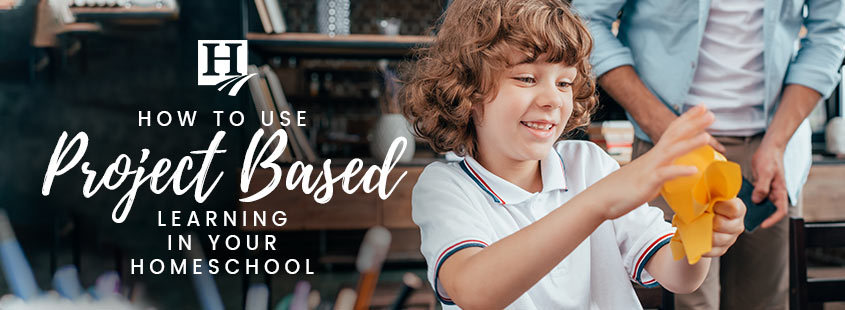As homeschoolers, we are all about making the learning process as authentic and applicable to real-world issues as much as possible for our children. With that in mind, we want to raise independent learners who are capable of finding solutions for themselves. The work field needs both staff and business owners who are motivated and develop innovative ideas. Homeschooling is a great option for raising these types of self-sufficient learners because homeschooling naturally encourages children to think outside the box. Thankfully, in addition to homeschooling as a whole, there are a few homeschooling styles to specifically encourage independent learning.
If you’re getting started homeschooling, you may have heard a few terms about homeschooling styles and methods. It can be difficult to differentiate the styles and determine the pros and cons versus the benefits of which would work best for your family. For encouraging child-led learning, one popular choice is project based learning, or PBL. If you are just now starting to homeschool, whether due to school closures or a mid-year switch, this method could be a great option.
What is Project-Based Learning?
To begin with, what exactly is project based learning, and how does it differ from traditional schoolwork? PBL is all about child-directed education and encouraging natural curiosity. We believe that children have the skills to find answers for themselves, we just need to guide and nudge them along the way. Project based learning begins with an open-ended question that interests the child, and then gives them free rein to research the answers. These are usually long-term projects that result in extensive research from multiple sources and several hands-on opportunities.
One of the greatest aspects of PBL is that it directly applies research and learning to real-life questions. Life is not neatly separated into subject groups, and consequently, project based learning oftentimes becomes a multi-subject opportunity for students, much like with unit studies. PBL is considered a child-led teaching method for engaging hands-on learning. By deeply researching a topic to answer the leading question, the project will teach via an indirect, exciting, and natural approach. Students learn through their curiosity and creativity. Project-based learning requires children to determine their question, and then follow-up with discovering the answer or solution on their own.
PBL is also considered experiential learning. This teaching method steps away from worksheets and textbooks and opens the learning experience to field trips, online research, videos, movies, museums, libraries, interviews, related classes, art, road trips, and more. The possibilities are endless and all in the pursuit of answering the homeschool project question. Imagine this metaphor for PBL in comparison to traditional teaching: classic schoolwork teaches students by sitting on the bleachers and observing a baseball game, while PBL teaches students by allowing them to participate as baseball players.
Benefits of Project Based Learning
The size of the homeschool project doesn’t matter. While PBL questions can typically result in long-term projects, it is fine if these projects are short-term as well. Not all questions require deep research and in-person visits to find the answers. As such, project based learning can easily adapt to any homeschooling lifestyle. If your particular state laws require structured lesson plans and testing, then PBL can become a complement to your core subjects study. If your state allows for unschooling, project based learning may be an excellent choice for your child-led education.
One of the best parts of PBL is that it utilizes your child’s existing skillset. Your homeschoolers do not need to be amazing at research or writing papers to benefit from project based learning. PBL meets the child where he or she is and encourages their already existing skills. As they begin project based learning, their problem-solving skills will develop, as will critical thinking, and communication skills.
Here are several benefits of project based learning for homeschooled students:
- Children embrace the learning process
- Real-world connections with academic concepts
- Students learn how to learn
- Works for any age, learning style, and even special needs
- Improved confidence and independence
- Students learn project management and organization skills
- Children will learn to overcome obstacles
- Improved memory retention and application
- Active learners versus passive
- A helpful assessment tool for students with test anxiety
- Explores topics and concepts across every core subject, including math, language arts, science, and social studies
- Develops teamwork and collaboration skills
- Develops and relies on creativity
- Perfect for summer learning
- A good solution for homeschool burnout
- Encourages students to explore their interests and hobbies
- Improves research skills
- May develop digital and technology abilities
- Works on conflict resolution
- Focuses on practical application, not rote memorization
How Can I Use Project-Based Learning as a Homeschooler?
While the theory behind project-based learning may sound great, getting started is a different process altogether. With experiential learning, homeschool parents may find it difficult to plan for projects or research avenues. Thankfully, there are ways to create project based learning lesson plans, they just look different from usual lesson plans or homeschool schedules. A homeschool project can be added to an already existing schedule when the mood strikes, or you can plan out a few project topics throughout the year as you create your homeschool schedule. There is no right or wrong, only however it works best for your family!
In a way, project based learning lesson plans encompass everything that is most appealing about homeschooling for the majority of people: flexibility, excitement, curiosity, child-led interest, boundless research and question-asking, and hands-on opportunities! In a nutshell, it hits on all the aspects of taking learning out of the traditional classroom and translating it into everyday life — which is the main objective of education in the end.
However, as mentioned earlier, it can be challenging to know where to start with experiential learning. As you begin planning your homeschool project, take a look at this step-by-step timeline for creating project based learning lesson plans.
- Determine the Question
- What question or problem interests your child? What would they like to discover or solve? Take a general question and look deeper into to see how you can make it open-ended for the most research possible. Add qualifiers and practical applications for a real-world scenario.
- Begin Planning
- What should the project look like? What is your timeline for this project? How much research and content do you expect from your child? Will you choose the final format of the project (video, slideshow, paper, 3D construction, multimodal, etc.) or will you leave that to your student’s discretion? What are your expectations and guidelines for your homeschooler to hit the brief?
- Research
- Help your student begin their research by determining the resources they can use. A younger student will need more assistance and guidance, while a high school student may be able to do it all on their own. Consider ideas like the library, Google Scholar, YouTube, textbooks, Google searches, Wikipedia, documentaries, National Geographic, NASA, and more.
- Presentation
- How should your student present the project? Should they merely complete the project and turn it in for your review, or should they present it to a club, community meeting, homeschool co-op, homeschool class, or before the family as their audience? The options are nearly endless, and they each offer individual merits.
Where to Find Project-Based Learning Resources
Across the nation, families depend on a variety of homeschooling styles. If you are just starting to homeschool, it may take some time before you know which of the homeschooling styles work best for you. Further, you may find yourself changing it every now and then if you are someone who thrives on variety! Getting started homeschooling doesn’t have to be overwhelming with project based learning. Instead, you can choose to do as little or as much as you like! Here are a few resources to help you with starting to homeschool. It’s a wonderful journey!




